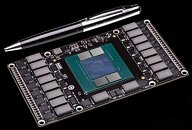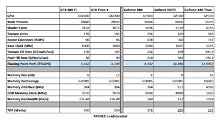- Joined
- Oct 9, 2007
- Messages
- 47,242 (7.55/day)
- Location
- Hyderabad, India
| System Name | RBMK-1000 |
|---|---|
| Processor | AMD Ryzen 7 5700G |
| Motherboard | ASUS ROG Strix B450-E Gaming |
| Cooling | DeepCool Gammax L240 V2 |
| Memory | 2x 8GB G.Skill Sniper X |
| Video Card(s) | Palit GeForce RTX 2080 SUPER GameRock |
| Storage | Western Digital Black NVMe 512GB |
| Display(s) | BenQ 1440p 60 Hz 27-inch |
| Case | Corsair Carbide 100R |
| Audio Device(s) | ASUS SupremeFX S1220A |
| Power Supply | Cooler Master MWE Gold 650W |
| Mouse | ASUS ROG Strix Impact |
| Keyboard | Gamdias Hermes E2 |
| Software | Windows 11 Pro |
With the GeForce GTX 900 series, NVIDIA has exhausted its GeForce GTX nomenclature, according to a sensational scoop from the rumor mill. Instead of going with the GTX 1000 series that has one digit too many, the company is turning the page on the GeForce GTX brand altogether. The company's next-generation high-end graphics card series will be the GeForce X80 series. Based on the performance-segment "GP104" and high-end "GP100" chips, the GeForce X80 series will consist of the performance-segment GeForce X80, the high-end GeForce X80 Ti, and the enthusiast-segment GeForce X80 TITAN.
Based on the "Pascal" architecture, the GP104 silicon is expected to feature as many as 4,096 CUDA cores. It will also feature 256 TMUs, 128 ROPs, and a GDDR5X memory interface, with 384 GB/s memory bandwidth. 6 GB could be the standard memory amount. Its texture- and pixel-fillrates are rated to be 33% higher than those of the GM200-based GeForce GTX TITAN X. The GP104 chip will be built on the 16 nm FinFET process. The TDP of this chip is rated at 175W.

Moving on, the GP100 is a whole different beast. It's built on the same 16 nm FinFET process as the GP104, and its TDP is rated at 225W. A unique feature of this silicon is its memory controllers, which are rumored to support both GDDR5X and HBM2 memory interfaces. There could be two packages for the GP100 silicon, depending on the memory type. The GDDR5X package will look simpler, with a large pin-count to wire out to the external memory chips; while the HBM2 package will be larger, to house the HBM stacks on the package, much like AMD "Fiji." The GeForce X80 Ti and the X80 TITAN will hence be two significantly different products besides their CUDA core counts and memory amounts.
The GP100 silicon physically features 6,144 CUDA cores, 384 TMUs, and 192 ROPs. On the X80 Ti, you'll get 5,120 CUDA cores, 320 TMUs, 160 ROPs, and a 512-bit wide GDDR5X memory interface, holding 8 GB of memory, with a bandwidth of 512 GB/s. The X80 TITAN, on the other hand, features all the CUDA cores, TMUs, and ROPs present on the silicon, plus features a 4096-bit wide HBM2 memory interface, holding 16 GB of memory, at a scorching 1 TB/s memory bandwidth. Both the X80 Ti and the X80 TITAN double the pixel- and texture- fill-rates from the GTX 980 Ti and GTX TITAN X, respectively.

View at TechPowerUp Main Site
Based on the "Pascal" architecture, the GP104 silicon is expected to feature as many as 4,096 CUDA cores. It will also feature 256 TMUs, 128 ROPs, and a GDDR5X memory interface, with 384 GB/s memory bandwidth. 6 GB could be the standard memory amount. Its texture- and pixel-fillrates are rated to be 33% higher than those of the GM200-based GeForce GTX TITAN X. The GP104 chip will be built on the 16 nm FinFET process. The TDP of this chip is rated at 175W.

Moving on, the GP100 is a whole different beast. It's built on the same 16 nm FinFET process as the GP104, and its TDP is rated at 225W. A unique feature of this silicon is its memory controllers, which are rumored to support both GDDR5X and HBM2 memory interfaces. There could be two packages for the GP100 silicon, depending on the memory type. The GDDR5X package will look simpler, with a large pin-count to wire out to the external memory chips; while the HBM2 package will be larger, to house the HBM stacks on the package, much like AMD "Fiji." The GeForce X80 Ti and the X80 TITAN will hence be two significantly different products besides their CUDA core counts and memory amounts.
The GP100 silicon physically features 6,144 CUDA cores, 384 TMUs, and 192 ROPs. On the X80 Ti, you'll get 5,120 CUDA cores, 320 TMUs, 160 ROPs, and a 512-bit wide GDDR5X memory interface, holding 8 GB of memory, with a bandwidth of 512 GB/s. The X80 TITAN, on the other hand, features all the CUDA cores, TMUs, and ROPs present on the silicon, plus features a 4096-bit wide HBM2 memory interface, holding 16 GB of memory, at a scorching 1 TB/s memory bandwidth. Both the X80 Ti and the X80 TITAN double the pixel- and texture- fill-rates from the GTX 980 Ti and GTX TITAN X, respectively.

View at TechPowerUp Main Site





 Yeah, it's stupid to have to buy Titan to get HBM.
Yeah, it's stupid to have to buy Titan to get HBM.



 ) and this sounds offensive xD It still stands as the best GPU I have ever got!
) and this sounds offensive xD It still stands as the best GPU I have ever got!